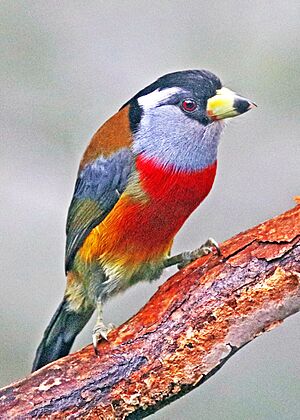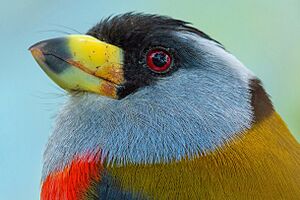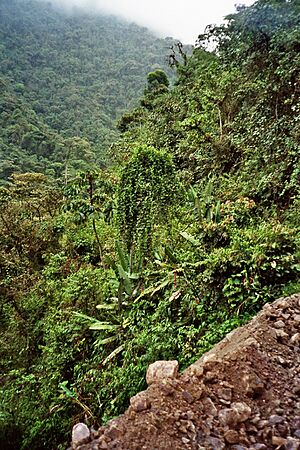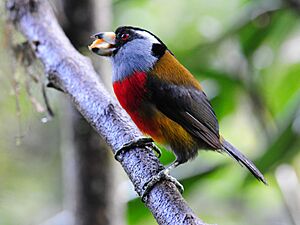Toucan barbet facts for kids
Quick facts for kids Toucan barbet |
|
|---|---|
 |
|
| A toucan barbet in Ecuador | |
| Conservation status | |
| Scientific classification | |
| Genus: |
Semnornis
|
| Species: |
ramphastinus
|
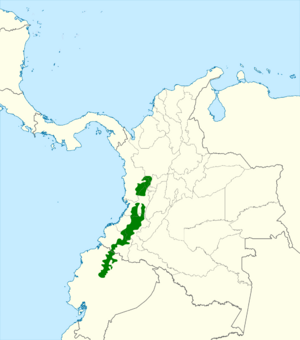 |
|
The toucan barbet (Semnornis ramphastinus) is a colorful bird found in western Ecuador and Colombia. It's part of a small bird family called Semnornithidae, and it's a close cousin to the well-known toucans. This medium-sized bird has a strong yellow beak and amazing feathers. Its head is black, with a gray throat and neck. It has a bright red chest and upper belly, a yellow lower belly, and gray wings and tail.
Toucan barbets live in humid mountain forests. They can be found high up in the trees, in both old and new forests, and even at the forest edges. These birds are very social. They live in small family groups that work together to protect their home. They also help each other raise their young. They eat fruits and various small animals, especially insects, which are important for baby birds. Sometimes, they even join other bird species to find food. They build their nests in holes they dig inside large, often dead, trees.
Young toucan barbets can be hunted by plate-billed mountain toucans. Sadly, the toucan barbet is considered near threatened. This means its numbers are decreasing. The main reason is that people catch them to sell as pets. Losing their forest homes, especially the big trees they need for nesting, also harms them. However, if left alone, these birds can adapt to some changes in their habitat.
Contents
Meet the Toucan Barbet Family
The toucan barbet was first described by a Scottish scientist named William Jardine in 1855. He gave it the name Tetragonops ramphastinus. The word ramphastinus means "toucan-like" in Latin, because of its big beak. Later, scientists realized this bird and its relative, the prong-billed barbet, were special. They were so unique that they were placed in their own family, Semnornithidae. This shows how closely related they are to toucans, even more than to other barbets around the world!
There are two types, or subspecies, of toucan barbets. One lives in Ecuador, and the other, called S. r. caucae, lives in Colombia.
What Does a Toucan Barbet Look Like?
The toucan barbet is a strong, medium-sized bird. It is about 19 to 21 cm (7.5–8.3 in) long and weighs between 80–115 g (2.8–4.1 oz). Its beak is very strong. The top part is yellow, and the bottom part is light green, both with dark tips. The beak also has small prongs at the end, but you usually can't see them easily.
Its feathers are very bright and colorful! It has a black top of the head, a black "mask" around its eyes, and a thin black collar. There's a clear white stripe behind its bright red eyes. The back of its neck is golden-brown, turning yellow towards its lower back. Its throat and upper chest are grayish-blue. The lower chest and middle belly are bright red, and the lower belly is yellowish-green. Its wings and tail are gray. The subspecies from Colombia has a little less red on its chest.
Male and female toucan barbets look almost the same. However, the female's colors are a bit less bright. Also, the female does not have a small tuft of feathers on the black part of her neck like the male does. Young toucan barbets are duller in color than adults. They don't get their beak prongs until they are about 4 months old.
Where Do Toucan Barbets Live?
These birds live in the wet forests of the western Andes mountains. You can find them from northwest Ecuador to southwest Colombia. They usually live at heights between 1,400–2,400 m (4,600–7,900 ft) above sea level. They use all parts of the forest, but they seem to prefer the upper parts of the trees, about 11–20 m (36–66 ft) high. They also use newer forests and areas at the edge of forests.
Toucan barbets are very picky about the trees they choose for nesting. They often pick old trees, especially those from the Lauraceae family. Since these large nesting trees are not very common, losing forests due to logging is a big problem for them.
Toucan Barbet Behavior
Toucan barbets are usually found in pairs or small groups. They often sit quietly on long tree branches, which makes them hard to spot unless they are moving or singing. Their flight is quick and noisy. They typically live in small groups of three to six birds.
These birds are very protective of their home areas, called territories. Their territories can be between 4–10.6 ha (9.9–26.2 acres) in size. Most of their territory is old, mature forest. However, they can live in forests that have some smaller areas of new growth or even pastures. Toucan barbet groups show strong territorial behavior towards other groups or species. They often sing loud duets to show other birds that the area is taken. The main breeding pair actively chases away intruders. Other birds in the family group, called "helpers," also assist, especially near the nest. If undisturbed, these groups can stay in the same territory for a year or even longer.
Calls and Sounds
Toucan barbet calls are easy to recognize. They are loud shrieks that can be heard from far away. The breeding pair usually sings these calls together, either at the same time or taking turns. They do this during the breeding season, mainly to mark their territory. The number of calls changes with the seasons. They call more often at the beginning of the year and less after April. Toucan barbets can also make clicking sounds.
If their nests are in danger from predators or other birds trying to steal their nesting spot, the group members make a rattling call. Then they peck and knock on the wood to scare the intruder away. If that doesn't work, the group will start to mob the intruder. Mobbing is when many birds attack a predator together. This behavior is more common when a whole group is involved, rather than just a pair.
What Do Toucan Barbets Eat?
Toucan barbets mainly eat fruit, but they also eat other foods. Studies show that New World barbets eat more fruit than other barbets, and their diet is similar to that of toucans. They have been seen eating 62 different kinds of fruit from 20 plant families. Fruits from Cecropia trees and Clusia trees are especially important for them. They also eat insects like termites, small reptiles, nectar, tree sap, and flower petals. What they eat changes with the season. For example, they eat more insects in April. Baby toucan barbets eat more insects than adults. About 54% of their diet is fruit, and 42% is insects.
Toucan barbets spend about 12 hours a day looking for food in their territory. They search from the ground up to 30 m (98 ft) high in the trees. They forage in small groups of up to six birds. Sometimes, they join mixed flocks with other birds like tyrant flycatchers, warblers, tanagers, and other fruit-eating birds.
Life Cycle and Reproduction
The toucan barbet is special among fruit-eating birds because it breeds cooperatively. This means several helper birds assist the main breeding pair with sitting on the eggs and raising the young. Groups are larger outside the breeding season. But during breeding, they usually shrink to three birds. These are often young birds from previous years who stay with their parents and help with the new babies. After the breeding season, the group grows again as they accept non-family members. These helpers greatly increase the chances of the breeding pair successfully raising their young.
The breeding season for toucan barbets is from February to October. A pair might have two or even three sets of chicks each year.
Toucan barbets dig holes in tree trunks with their strong beaks. They use these holes to sleep and to nest. The nesting holes are usually dug into dead trees, often broken tree trunks. Sometimes, they use a dead branch in a living tree. Both male and female birds sit on the eggs. In nests without helpers, males spend more time incubating and brooding than females. The eggs hatch after 15 days. The young birds leave the nest after 45 days. Young birds look a lot like adults, but their colors are paler, and their eyes are black. They keep their juvenile feathers for at least 2 months after leaving the nest.
Who Hunts Toucan Barbets?
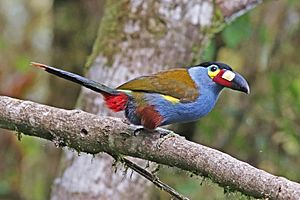
Toucan barbets compete with plate-billed mountain toucans for nesting spots. These toucans also hunt young toucan barbets in the nest. White-faced capuchin monkeys and Neotropical dwarf squirrels are also seen as threats to nesting sites by family groups. Not much is known about their parasites, but tiny feather mites have been found on them.
Protecting the Toucan Barbet
The toucan barbet is listed as near threatened by the IUCN. This means its numbers are decreasing. Even though it's still somewhat common in certain areas, its populations have gone down. This is due to losing its habitat because of massive logging, cutting down forests, cattle farming, and mining.
However, the biggest threat to this bird is illegal trapping for the pet bird trade, both locally and internationally. This is because the toucan barbet can adapt to some changes in its habitat if people leave it alone. Heavy trapping and forests being broken up into smaller pieces are thought to be why this species has disappeared from some areas.



